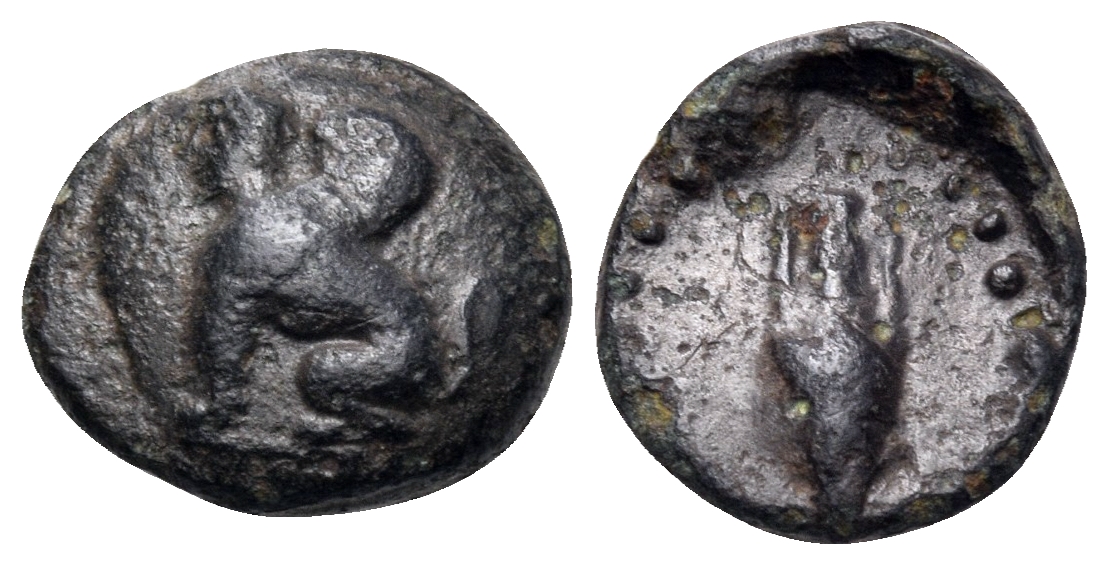2366 - Rhodes (AE - Rhodos/rose) over Chios (Sphinx/amphora) (Ashton coll.)
From SILVER
350 BCE - 300 BCE | ΡΟ
Images
Overstruck variety Traces of the overstruck variety
Traces of the overstruck variety

Chios 1484 (overstruck).jpg [1]
Location/history
| Private collection(s)Private collection(s) ᵖ: | R. Ashton collection | Archaeological contextArchaeological context: | IGCH 1287 = CH 2, 59 |
Overstriking coin
Description
| ObverseInscription or printing placed on the obverse.: | Head of nymph Rhodos right. | ReverseInscription or printing placed on the reverse.: | ΡΟ (Greek) Rose with bud. In left field, uncertain symbol. |
Mint and issuing power
| MintIdentifies the place of manufacture or issue of a numismatic object.: | Rhodes | Ancient regionAncient region. | Caria (islands) | Modern countryModern country: Greece | AuthorityIdentifies the issuing power. The authority can be "pretended" when the name or the portrait of X is on the coin but he/she was not the issuing power. It can also be "uncertain" when there is no mention of X on the coin but he/she was the issuing power according to the historical sources: |
Chronology
| FromIdentifies the initial date in a range assigned in a numismatic context. 350 BCE toIdentifies the final date in a range assigned in a numismatic context.. 300 BCE | Classical 480-323 BC |
Physical description
| MetalThe physical material (usually metal) from which an object is made.: Bronze |
WeightWeight of the numismatic object (in grams). in grams: 1.031.03 g <br />1,030 mg <br /> | AxisDescribes the directional relationship between the obverse and reverse of a numismatic object.: 1212 mm <br />1.2 cm <br /> | |
| DiameterDescribes diameter of an object (in mm).: 1111 mm <br />1.1 cm <br /> | |||
References
| Coin referenceReference of the Coin: | Ashton - Kinns 2003, p. 30-31, pl. 5. | Coin series referenceReference to coin series study: | Sear II1Sear II, n° 5071, HGC 62HGC 6, n° 1476 or 1479 |
| Coin series web referenceCoin series web references: | |||
Overstruck type
Description
| ObverseInscription or printing placed on the obverse.: | Sphinx seated left (visible on reverse) | ReverseInscription or printing placed on the reverse.: | ΧΙΟΣ Amphora (visible on obverse: top of amphora, letters) |
Mint and issuing power
| MintIdentifies the place of manufacture or issue of a numismatic object. ᵖ: | Chios | Ancient regionAncient region. ᵖ | Ionia | Modern countryModern country: Greece | AuthorityIdentifies the authority in whose name (explicitly or implicitly) a numismatic object was issued. ᵖ: |
Chronology
| FromIdentifies the initial date in a range assigned in a numismatic context. 375 BCE toIdentifies the final date in a range assigned in a numismatic context.. 350 BCE | Classical 480-323 BC |
Physical description
References
| Coin type referenceReference to coin series study ᵖ: | Hardwick 19913Hardwick 1991, n° 11a, HGC 62HGC 6, n° 1154 | ||
| Coin series web reference overstruckCoin series web references overstruck: | |||
Additional data
| Frequency of overstrikesFrequency of overstrikes: | exceptional | Level of confidenceLevel of confidence of the identification: | strong |
| RemarksRemarks: | |||
References
- ^ Sear, David R. (1979), Greek coins and their values. Vol. II, Asia and North Africa, London, xlviii, p. 317-762
- a b Hoover, Oliver D. (2010), The Handbook of Greek Coinage Series, volume 6 : handbook of coins of the islands: Adriatic, Iionian, Thracian, Aegean, and Carpathian seas (excluding Crete and Cyprus), sixth to first centuries BC, Lancaster, 358 p.
- ^ Hardwick, Nicholas (1991), The coinage of Chios from the sixth to fourth century B.C., Oxford, unpublished DPhil, xvi + 316 p.

